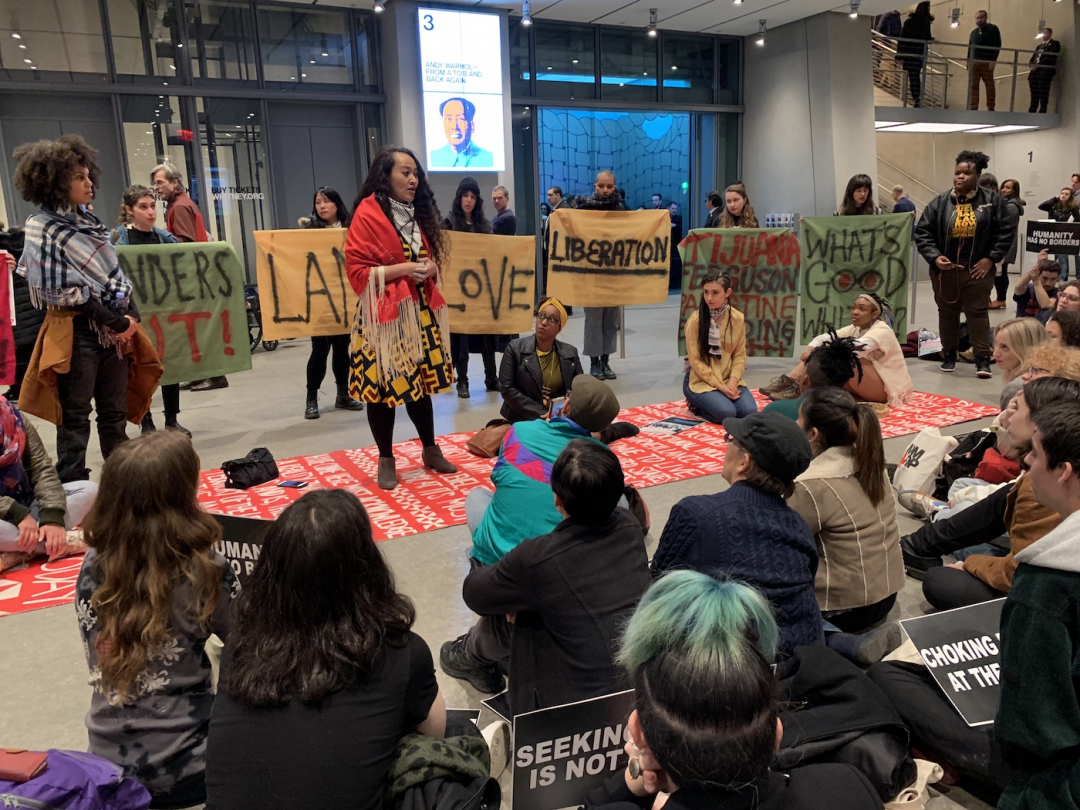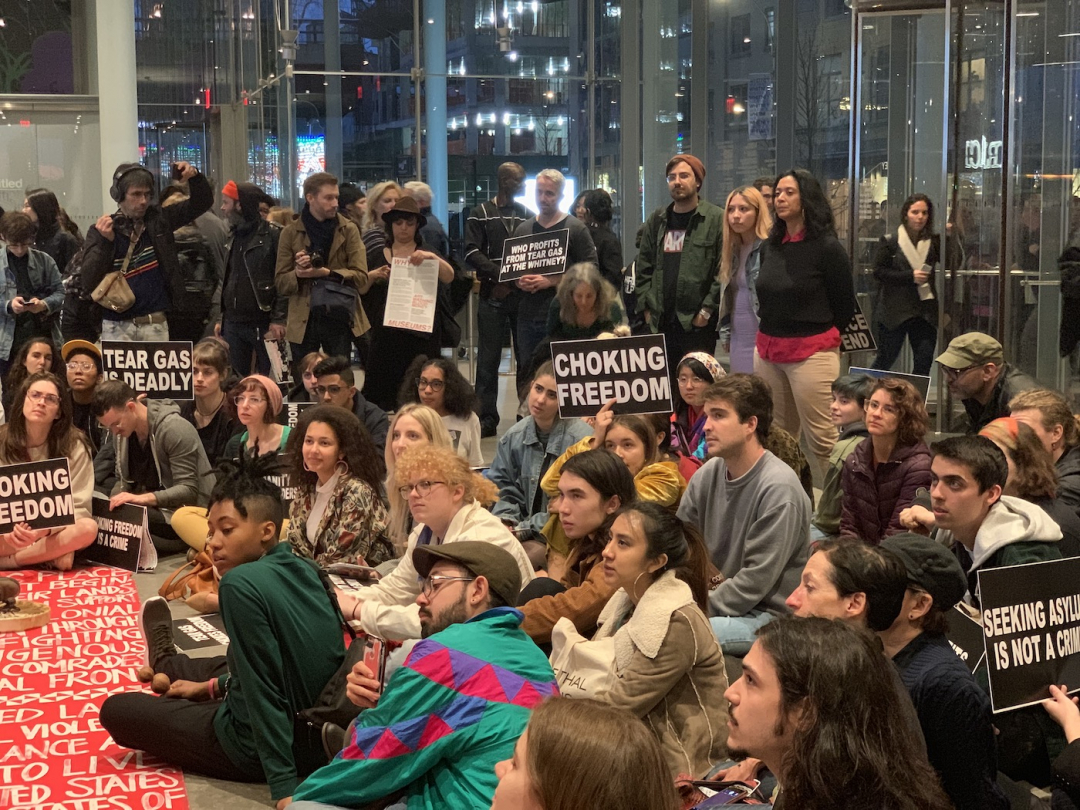Whitney Protests: Nine Weeks of Art + Action
This story originally appeard in Hyperallergic.
By Zachary Small
The second in a scheduled “Nine Weeks of Art and Action” organized by the movement Decolonize This Place began with a huddle of singers and a sonorous chant. Activists gathered to discuss their upcoming demonstration; they began disseminating their flyers to museumgoers and discussing strategy. Posters were also passed around, some of which read “seeking asylum is not a crime” and “choking freedom at the Whitney.”
Artist and poet Vaimoana Niumeitolu led this week’s protest with four other women who instructed the crowd of nearly 70 protesters in how to sing songs of liberation, which included Indigenous chants and Black freedom songs.
“This is about sharing with all our ancestors. This is about love, and this is about land, and this is about liberation,” she announced to the demonstrators, gathering crowd of tourists, and museum staff, “Today, there is no more shame. Bring that love out and sing with us.”
Protesters were in the Whitney Museum’s lobby to demand the removal of one of the cultural institution’s vice chairmen, Warren Kanders. A November report by Hyperallergic identified Kanders as supplying the Trump administration with tear gas canisters and smoke grenades through his multi-billion dollar weapons manufacturing company, Safariland. The company’s anti-riot ballistics have appeared in political clashes around the world from Standing Rock to Baltimore, Ferguson, and Gaza. They also announced a $7.3 million sale of ballistic equipment to the NYPD in 2016. More recently, Safariland canisters were found at the US–Mexico border after American patrolmen launched them at Central American asylum-seekers.
Activists and museum employees have called for Kanders to step down from his position with the Whitney; they have also asked the preeminent cultural institution for better transparency and ethical guidelines on how it selects board members and trustees.
Protesters standing on a rug featuring text acknowledging that their protest was taking place on the Indigenous lands of the Lenape people
Before the events, Nitasha Dhillon was distributing baklava and other desserts to museum employees. “This week, we are giving out sweets before we start our action,” the artist and Decolonize This Place activist explained. “We’ve been centering the staff in all our actions. We’ve been trying to work with staff so there’s no extra work with them.”
“We are artists who come from communities where tear gas effects us on a day-to-day level. What we are doing here is holding our cultural institutions accountable. Art is not separate from what’s happening in the world.”
A little girl with a Coca-Cola bottle watches the protest
Shortly after the November Hyperallergic report, Whitney director Adam Weinberg wrote his staff and trustees about the controversy, describing the Whitney as “a safe space for unsafe ideas.”
Kanders’s response to staffers struck a more direct tone, which aimed to separate the businessman from his company’s weaponry. “I think it is clear that I am not the problem the authors of the letter seek to solve,” he wrote.
Since then, activists have signaled an intention to broaden their inquiry toward other “bad” board members at the Whitney; a newly formed group calling itself D_IRT recently circulated an image on social media identifying 16 more persons of interest on the museum’s board of trustees list. During a January town hall meeting held by Decolonize This Place, participants also expressed their desire to look at the wealthy patrons at other museums like the Museum of Modern Art and the Metropolitan Museum of Art.
Protesters surrounded the singers with signs calling for liberation, love, and the resignation of Kanders
More than a dozen museum staff and security guards watched as protesters sang melodies like “Down by the Riverside.” They were somewhat perplexed by the action. “They’re singing songs about liberation, just be aware.” said one guard over his walkie-talkie — a message that could be heard throughout the lobby. “LOWER THE RADIO!” shouted back another.
The Whitney Museum has declined to comment.
A portion of the crowd of demonstrators
But protesters were undaunted by their observers. Alma, a writing student at the New School, came to last week’s protest and believes the demonstrations are gaining momentum. “By mobilizing people, that’s how these things start,” they explained. “It’s just going to get bigger and bigger.”
The art world may be well-aware of the Kanders controversy, but some museumgoers are just learning about the weapons manufacturer. Ana had come to the Whitney with two friends to enjoy the museum’s pay-what-you-wish special for Friday evening admissions, but instead, she stumbled upon the protest. Having just moved to the city, she was surprised that there wasn’t more publicity about the board member. “I think the protesters have an achievable goal if they want this one person to be removed. The institution will survive without him,” she said. “He’s not a necessary part of why people come to see art.”
Her friend agreed. “This is what should be happening at the Whitney,” he said. “The Whitney is always going to be here and the fact that one person is tainting its image — it’s not that hard to get him out of here.”
Demonstrators and onlookers sit to watch the activist action
Other onlookers were having a hard time processing how a museum could have ties to weapons manufacturing. One woman who had come to visit the museum with her young son took him aside near the gift shop; she began explaining to him how tear gas works.
A man in his seventies stopped one of the protesters to ask what they were demonstrating about. An activist explained how the museum was linked to the border crisis through one of its board members. The man raised his eyebrows, sighed, and shrugged before saying, “He must have a lot of money.”
Protesters continued singing, bringing their voices to a harmonious and high pitch that stopped most visitors in their tracks.
“Welcome back to the sixties,” said one elderly woman to another on her way to the museum exit.







